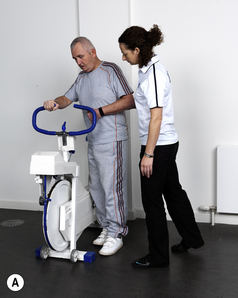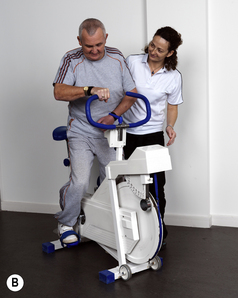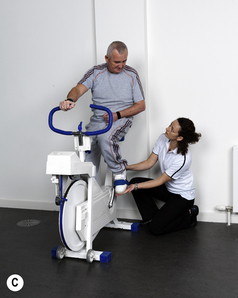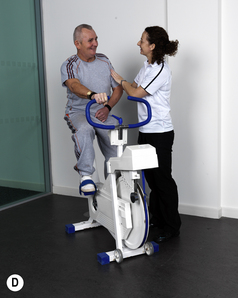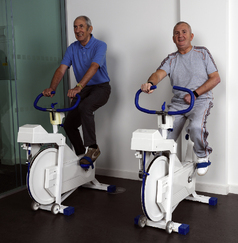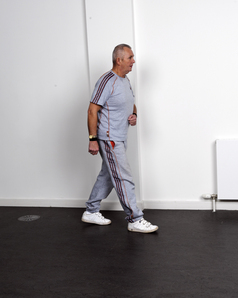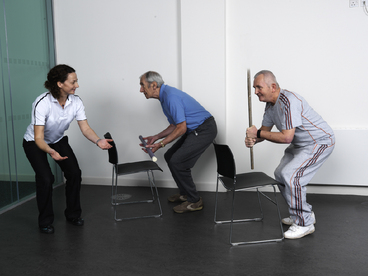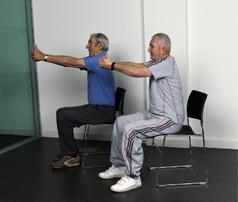10 Designing and delivering an exercise and fitness training programme for stroke survivors
Introduction
The approach presented here is based on a combination of evidence, including the STARTER trial (Mead et al. 2007), the Cochrane systematic review discussed in chapter 5 (Brazzelli et al. 2011, Saunders et al. 2004, 2009), best practice from the fields of exercise and physiotherapy, as well as published recommendations drawn from national documents including the Best Practice Guidelines for community-based Exercise after Stroke services (Best et al. 2010).
Starting point: safety first
Risk assessment and management
Safety first
‘Safety first’ has to be the starting point when designing a progressive exercise programme for stroke survivors (Dinan and Dennis 2010). This is due to the complex, multiple and often variable difficulties that stroke survivors may experience, and to the inherent underlying cardiac risk present in a significant portion of the stroke population, as highlighted in chapter 9. Assessing risks and adjusting exercise to the individual takes into consideration individual factors (including clinical, physiological, psychological and age-related), exercise-related and environmental factors that may increase the risk of an injury or adverse event during exercise. Risk assessment, stratification and management are crucial for safe, effective session design and for the progression of exercise.
Prior to commencing an exercise programme
Chapter 9 detailed the risk assessment procedures that need to be completed for stroke survivors prior to their enrolment in an exercise programme. A risk management plan should have been agreed with the referring health professional in advance for predictable adverse events that might occur in an exercise session. This plan needs to take into account any medical problems. For example, in stroke survivors with diabetes, agreement needs to be reached about the dose of insulin prior to exercise and the management of hypoglycaemia in response to exercise.
Exercise professionals need to be aware that stroke survivors may take medication, not only for secondary stroke prevention but also for co-morbidities (chapter 3). They need to know the effects and potential adverse effects of all these medications on the stroke survivor’s ability to exercise safely (chapter 9). Detailed information about drugs and their side effects can be found in the British National Formulary.
Prior to each session
Prior to each session, the exercise professional needs to assess the risks associated with the individual stroke survivor, the exercise programme, as well as the equipment and the facility, to ensure compliance with local regulations. Each element of the risk assessment described in chapter 9, to be undertaken before a stroke survivor starts an exercise programme, also needs to be checked before each exercise session. The nature of the post-stroke fluctuations in health and functional capacity and the likelihood of ‘off’ days (e.g. due to fatigue, poor motivation, depression) make it necessary for the exercise professional to check on and gather information from individual stroke survivors prior to each session. The exercise professional needs to ask each individual whether there has been any change in their medical condition, or anything else that has happened since the previous session that might impact on their safety. Resting heart rate is often taken and blood pressure as required, depending on local protocol. If the stroke survivor enters a session feeling unwell, or with new symptoms that might impact on their safety, the exercise professional must recommend that the stroke survivor does not exercise, but seeks medical advice prior to resuming exercise. This should only occur once the individual has been given permission by their general practitioner (GP).
Ongoing monitoring of participants
Exercise professionals should continually monitor performance and anticipate having to tailor exercises for individual stroke survivors. They should ensure that stroke survivors initiate each exercise safely. For example, a carefully staged approach is required for a stroke survivor with hemiplegia when mounting an exercise bike (Fig. 10.1). Exercise professionals should also monitor the stroke survivor’s response (including tone) to strengthening/endurance exercises, whether the stroke survivor is undertaking exercises and performing movement patterns safely and effectively.
Exercise professionals must be able to recognise the signs and symptoms that require stroke survivors to be signposted back to their GP or other appropriate health professional. Chapter 3 covered the common co-morbidities that the exercise professional needs to be aware of and the possible approaches to their emergency management; additional recommendations on emergency situations are provided below.
Emergency procedures
Each exercise location will have its own operational policy for management of emergencies – including medical and other emergencies, e.g. fire. Exercise professionals should familiarise themselves with the legal framework for emergency procedures in their place of work before commencing at that location. All health, safety and emergency requirements must be conscientiously and regularly checked and all required procedures must be followed. All first aid equipment and emergency links must be operational, e.g. an on-site telephone and a designated staff member should be available for the duration of the session and, ideally, to assist with access to and from the session. In addition to the emergency plan, Box 10.1 provides other examples of the requirements that should be in place. These may vary across different services and countries, but in the authors’ opinion these are the minimum requirements. Box 10.2 lists emergency procedures for Exercise after Stroke services, which may vary in different countries.
Box 10.1 Health and safety requirements for exercise and fitness training after stroke services
 All staff should have first aid training in order to assess and manage incidents
All staff should have first aid training in order to assess and manage incidents
 All staff must be trained appropriately in cardiopulmonary resuscitation
All staff must be trained appropriately in cardiopulmonary resuscitation
 All staff should be trained in manual handling to be able to assist if a fall has taken place. Also, if specialist lifting equipment is available, all staff should be familiar with its use
All staff should be trained in manual handling to be able to assist if a fall has taken place. Also, if specialist lifting equipment is available, all staff should be familiar with its use
 There should be an alarm/immediate phone access in the facility to summon additional help
There should be an alarm/immediate phone access in the facility to summon additional help
Box 10.2 Emergency procedures for Exercise after Stroke Services
 Contact the emergency services and apply usual first aid and resuscitation as required
Contact the emergency services and apply usual first aid and resuscitation as required
 If new symptoms of stroke/cardiac condition arise, contact the emergency services
If new symptoms of stroke/cardiac condition arise, contact the emergency services
 Return to exercise is not permitted until the general practitioner/other appropriate health professional has reviewed the case and acknowledges the appropriateness of resuming exercise
Return to exercise is not permitted until the general practitioner/other appropriate health professional has reviewed the case and acknowledges the appropriateness of resuming exercise
Programme aims
The primary aim of each exercise session should be:
• To improve all components of physical fitness (see below), with priority given to cardiovascular endurance, functional muscle strength and endurance in order to achieve optimum health and functional gain, while promoting psychosocial wellbeing.
Secondary session aims should include the following:
• To improve the performance of specific everyday functional activities of daily living (ADLs) and instrumental activities of daily living (IADL) with an emphasis on normalising posture, movement and function.
• To promote achievement of the stroke survivor’s specific short- and long-term personal goals as well as more general health and functional outcomes.
• To enhance self-efficacy and self-management in relation to physical activity.
Improving components of fitness
In general, health-related exercise programmes should aim to include the following components of physical fitness (ACSM 2010):
• Motor skills and coordination (i.e. agility, coordination, balance, power, reaction time and speed).
For ambulant stroke survivors, evidence indicates that the three fitness components that need to be prioritised are cardiovascular/cardiorespiratory endurance, muscle strength and muscle endurance (chapters 4 and 5). This is not to say that the other components should not feature in the programme, but rather that the cardiovascular, muscle strength and endurance components should be the focus. However, any gains in these fitness components must be able to support the ability to undertake daily functional activities. For many ambulant stroke survivors, problems with balance, coordination and limited range of movement affect their ability to undertake such activities. Thus, in the context of exercise and fitness training after stroke, cardiovascular/cardiorespiratory endurance, muscle strength and endurance all need to be trained in the context of functional activities. Exercise professionals should have a clear understanding of the rationale for each exercise in terms of how this targets the components of fitness, relates to functional activities and each individual’s goals.
Whilst body composition is included as a component of physical fitness in the ACSM terminology (2010), it is not considered here as a factor in the design process, but rather as a programme outcome.
Cardiovascular endurance
As discussed in chapter 4, cardiorespiratory fitness (or ‘aerobic fitness’) is the central capacity of the circulatory and respiratory systems to supply oxygen, together with the peripheral capacity of skeletal muscle to utilise oxygen. Any rhythmic, aerobic, continuous activity involving the large muscle groups that is maintained for a prolonged period of time, increases heart rate and the return of blood to the heart, can improve cardiovascular fitness.
Stroke survivors are known to have generally lower levels of cardiovascular fitness compared to healthy age-matched controls, which impacts on health and everyday life (Saunders et al. 2009; chapter 4). This considerable shortfall in fitness needs to be addressed by appropriate strength and endurance training.
Cardiovascular fitness after stroke can be improved through exercise programmes that include walking (Brazzelli et al. 2011, Saunders et al. 2009). The authors suggested that other modalities should also be considered, depending on the individual’s functional capacity and goals. As stroke survivors make certain physical fitness and functional gains, a wider range of exercise opportunities may be appropriate, e.g. walking, cycling, swimming (Figs 10.2 and 10.3).
A key consideration when designing a programme for cardiovascular fitness is to address balance and coordination impairments. This can be achieved by including some dynamic endurance activities (e.g. side stepping, knee-to-hand) and by selecting exercise modalities that enhance safety. Box 10.3 provides an example of how a cardiovascular endurance exercise can be tailored for an individual stroke survivor with balance difficulties and muscle weakness.
Box 10.3 Example of tailoring a cardiovascular endurance exercise for an individual stroke survivor
A ‘step-up’ exercise (Figs 10.23 and 10.24) is a good example of an aerobic exercise; however, eliciting a cardiovascular response on this exercise may be hampered by poor dynamic balance coupled with muscle weakness. In this case, the exercise professional should consider offering more support or an alternative targeted exercise that requires less balance (e.g. forward/backwards weight transfer with upper limb support for balance on a level floor), which may enable a more fluid and rhythmical movement pattern.
If the stroke survivor is demonstrating asymmetry of trunk posture (e.g. shortening on one side of their trunk while completing a more strenuous exercise like the step-up), then balance is more likely to be at risk due to a lateral shift in their centre of gravity. This can be counteracted by prompting the stroke survivor to correct their posture, by adding a tailored corrective side stretch prior to and at the end of the exercise (Fig. 10.7), or by altering it to a bilateral exercise, such as sit to stand or squat with their back supported against the wall.
Muscular strength, power and endurance
Muscle strength is the maximum force or torque that can be generated by a specific muscle or muscle group (chapter 4). The higher the resistance during a strength exercise, the lower the number of repetitions achievable. Health-related weight training typically features 6–12 repetitions, competitive weight lifting features 2–5 repetitions until a maximal contraction is required, which is progressed to just one repetition for Olympic weight lifting. Chapter 4 explained the correlations between levels of muscular strength and the ability to undertake everyday activities (Kraemer and French 2005, Saunders et al. 2008). For example, hip flexor and knee flexor/extensor strength of the affected leg are key factors in walking performance and in negotiating stairs (Flansbjer et al. 2006, Le Brasseur et al. 2006).
Applying the exercise science concepts underpinning health-related weight training to exercise after stroke requires additional knowledge and skills to ensure the approach takes account of any possible muscle tone abnormalities and underlying cardiac pathology. It should also be consistent with the principles of skill acquisition and strengthening used in exercise and therapy settings, e.g. training should ideally match everyday functional activities to enhance functional gain (Skelton et al. 1994, 1995, Skelton and McLaughlin 1996). This is because strength training, like any form of training, is highly specific. An example is a bench press (lying down), which does not functionally match pushing a heavy door open with one arm (standing). Box 10.4 and Figures 10.4 and 10.5 provide other examples of how a muscular strength exercise could be tailored to an individual stroke survivor.
Box 10.4 Example of tailoring a muscular strength exercise for an individual stroke survivor
In the STARTER trial (Mead et al. 2007), an upper limb strengthening exercise might be the standing ‘ball raise’. This exercise is designed to improve lifting capacity and core stability while maintaining an active base of support.
A stroke survivor with increased upper limb tone may need to alter their hand position on the ball to accommodate their lack of supination (i.e. bringing their palm upwards) or use a smaller ball (Fig. 10.26).
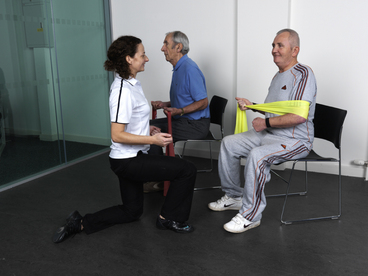
Fig 10.4 Exercises requiring grip must be tailored to prevent increased tone, e.g. ‘upper-back strengthener’.
When designing the strength element of a training programme for stroke, the focus is on improving performance of functional movement patterns and activities involving both sides of the body. These training activities, therefore, need to reflect the specific movement patterns, including movement speed and postural changes, of actual functional activities. An exercise such as the ‘pole raise’, which reflects taking an object from a low to a higher level (e.g. a table to a shelf) and vice versa while encouraging postural symmetry, is an example of a useful exercise for training this functional task (Fig. 10.5).
For stroke survivors, improving weakness and reduced function in their affected arm often features on their list of goals, particularly if this is related to activities such as holding a dog lead, carrying shopping or getting dressed. The potential for improvements in arm function varies, and depends on the initial level of impairment (Nakayama et al. 1994), type of stroke, time since stroke and rehabilitation received. As chapter 5 has shown, evidence indicates that strength gains are achievable, even in affected limbs – as long as there is no paralysis (Duncan et al. 2003).
A key consideration for stroke survivors must be to limit any adverse increases in muscle tone through inappropriate application of force. For example, forcing the execution of a stretching exercise or using a weight in the hand of the affected side in a severely affected upper limb to increase range of movement in that limb is contraindicated due to the risk of permanent joint damage. The shoulder is particularly at risk of injury after stroke, as the shoulder joint may sublux (dislocate) when any muscle weakness or muscle imbalance is present, which can have long-lasting pain and functional deficits as a result (chapter 3). Any significant manual stretching should only be administered under direct guidance/supervision of a suitably qualified health professional. It is reasonable, however, for the stroke survivor to actively self-stretch tight or ‘tonal’ muscle groups, either by using their intrinsic opposition muscle groups of that limb, or by using active assisted exercises (e.g. clasping hands and gently stretching forward to achieve biceps/brachialis lengthening; Fig. 10.6). In active self-stretching, the stroke survivor is in control of their own movement within a pain-free range, and the exercise professional should monitor closely that this remains within an agreed range of movement, pre-determined by information from the referring health-care professional.
Maximal or near maximal muscular contractions, such as those required to lift extremely heavy weights, are not recommended, as they often lead to a stroke survivor altering their posture inappropriately to complete the action, regardless of the loss of correct form. This can lead to poor posture and an increase in abnormal tone which can affect subsequent function and increase the risk of injury (e.g. a fall, back or joint injury). Maximal effort against high resistance is also associated with a decreased venous return and an elevation in arterial blood pressure. These adverse effects can be exacerbated if the resistance exercises are incorrectly performed, such as by holding the breath during the movement, causing an acute increase in blood pressure due to the physiological mechanism known as the Valsalva manoeuvre (Brooks 1997). Therefore, whilst carefully prescribed, cautiously progressed and closely monitored weight training has been shown to be beneficial in restoring function after stroke, heavy and intense weight training is contraindicated.
Muscular power output is defined as the greatest rate of work achieved during a single, fast, resisted contraction (chapter 4). It is the ability to combine the fitness components of strength and speed to produce a movement under load at a given speed. Getting activities done faster is usually not a priority for stroke survivors, but improving function often is. Chapter 4 explained the relationship between muscle power and function, e.g. knee extensor power, particularly on the affected side, is the most important factor predicting comfortable walking speed and stair climbing (Le Brasseur et al. 2006).
Finally, with regards to training muscle endurance after stroke, the exercise professional should focus on improving efficiency of movement so that a particular function may be achieved with less energy expenditure. ‘Normalising movement’ is the remit and concern of the physiotherapist, but the exercise professional’s priority is to ensure that repetitive movement is sustainable without increasing compensatory patterns or hypertonia. In fact, repetition of pain-free movement may help to increase range of movement by reducing soft tissue thixotropy. Where there is hypertonia (chapter 3), repetition of pain-free movement should be encouraged whenever possible (Axelson 2005, Lakie and Robson 1988, Vattanslip et al. 2000).
Stay updated, free articles. Join our Telegram channel

Full access? Get Clinical Tree


